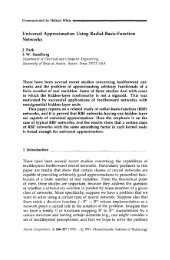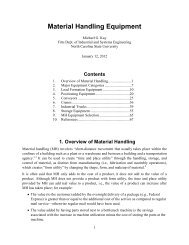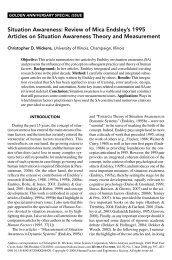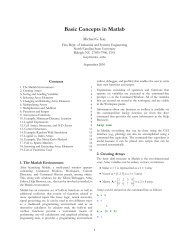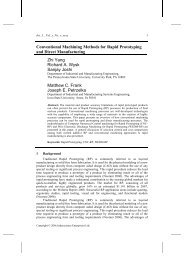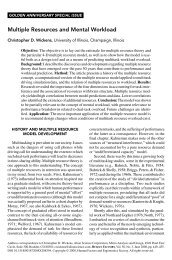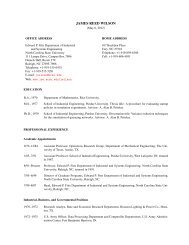Approximation by superpositions of a sigmoidal function
Approximation by superpositions of a sigmoidal function
Approximation by superpositions of a sigmoidal function
You also want an ePaper? Increase the reach of your titles
YUMPU automatically turns print PDFs into web optimized ePapers that Google loves.
<strong>Approximation</strong> <strong>by</strong> Superpositions <strong>of</strong> a Sigrnoidal Function 309<br />
then we know that x ~ P~ and we can classify x accordingly. The issue is whether<br />
such a decision <strong>function</strong> can be implemented <strong>by</strong> a network with a single internal<br />
layer.<br />
We have ihe following fundamental result.<br />
Theorem 3. Let a be a continuous <strong>sigmoidal</strong> <strong>function</strong>. Let f be the decision <strong>function</strong><br />
for any finite measurable partition <strong>of</strong> In. For any e > O, there is a finite sum <strong>of</strong> the<br />
form<br />
N<br />
G(x) = Y, + 0 r)<br />
j=l<br />
and a set D ~ In, so that re(D) > 1 - ~ and<br />
IG(x) - f(x)l < e for x ~ D.<br />
Pro<strong>of</strong>. By Lusin's theorem [R1], there is a continuous <strong>function</strong>, h, and a set D with<br />
re(D) > 1 - e so that h(x) = f(x) for x E D. Now h is continuous and so, <strong>by</strong> Theorem<br />
2, we can find a summation <strong>of</strong> the form <strong>of</strong> G above to satisfy IG(x) - h(x)l < e for<br />
all x e I~. Then for x E D, we have<br />
IG(x) - f(x)l = IG(x) - h(x)l < e.<br />
Because <strong>of</strong> continuity, we are always in the position <strong>of</strong> having to make some<br />
incorrect decisions about some points. This result states that the total measure <strong>of</strong><br />
the incorrectly classified points can be made arbitrarily small. In light <strong>of</strong> this,<br />
Thoerem 2 appears to be the strongest possible result <strong>of</strong> its kind.<br />
We can develop this approximation idea a bit more <strong>by</strong> considering the decision<br />
problem for a single closed set D c I~. Then f(x) = 1 if x E D and f(x) = 0 otherwise;<br />
f is the indicator <strong>function</strong> <strong>of</strong> the set D c I~. Suppose we wish to find a summation<br />
<strong>of</strong> the form (1) to approximate this decision <strong>function</strong>. Let<br />
A(x, D) = min{lx - Yl, Y ~ D}<br />
so that A(x, D) is a continuous <strong>function</strong> <strong>of</strong> x. Now set<br />
9<br />
~(x) = max 0,<br />
e<br />
so that f~(x) = 0 for points x farther than e away from D while f~(x) = 1 for x z D.<br />
Moreover, ~(x) is continuous in x.<br />
By Theorem 2, find a G(x) as in (1) so that IG(x) - ~(x)l < 89 and use this G as an<br />
approximate decision <strong>function</strong>: G(x) < 89 guesses that x E D c while G(x) >__ 89 guesses<br />
that x r D. This decision procedure is correct for all x ~ D and for all x at a distance<br />
at least ~ away from D. If x is within e distance <strong>of</strong> D, its classification depends on<br />
the particular choice <strong>of</strong> G(x).<br />
These observations say that points sufficiently far away from and points inside<br />
the closed decision region can be classified correctly. In contrast, Theorem 3 says<br />
that there is a network that makes the measure <strong>of</strong> points incorrectly classified as<br />
smat! as desired but does not guarantee their location.



